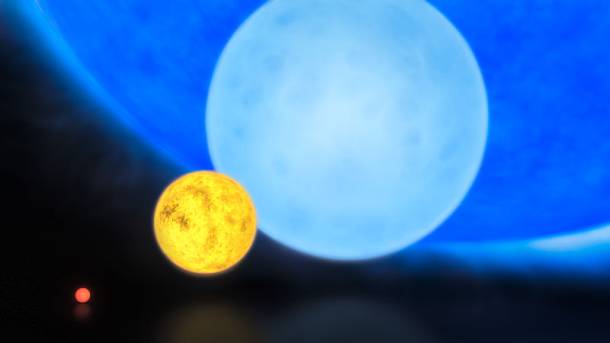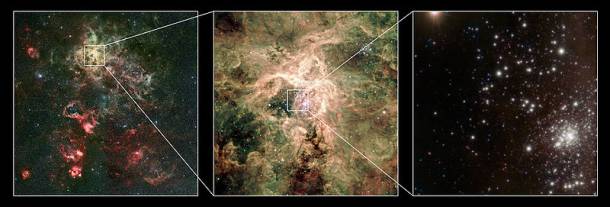Space remains one of the few frontiers left for humanity to explore – and what a vast frontier it is. Yet despite the enormity of the challenge, we’re making progress everyday – with the recent Curiosity landing on Mars, and even a planned human expedition to the Red Planet in the works for 2018.
With such a vast expanse of stars and planets, constantly expanding, changing, a common question we get from those attempting to grasp the vast magnitude of space is “what’s the biggest star in the universe?”.
While it’s certainly an appropriate question, it’s not such a simple answer. What measurements should we use to determine the largest star in the universe (or at least, the largest known star)? There are 3 measurements we can use to gauge in an attempt to crown the biggest star in the universe:
- Solar radii (a measurement based on the radius of our sun)
- Solar mass (a measurement based on the mass of our sun)
- Luminosity (a measure of power).
So while solar radii would give us the “largest star in universe” by radius/circumference, it wouldn’t give us the most massive star (solar mass), or the most powerful star (luminosity). With that in mind, let’s take a look at some of the largest stars, most massive stars, and most powerful stars in the known universe.
The Largest Star By Volume

The Cyg OB2 association (Photo credit: Wikipedia)
The inherent problem with measuring stars - despite modern technology like the Hubble Space telescope and huge advances in observation technology - is that the objects you are trying to measure are thousands of light years away. Astronomers have to gaze through intergalactic dust, take into account the proximity of other stars, and many other factors that make it difficult to narrow exactly how large the stars are.
A great example of this difficulty is our measurement of the star designated KY Cygni. Astronomers once measured this star as having a radius of 2,850 of our Suns (approximately 1,982,175,000 kilometers). However, recent observations have determined that KY Cygni is most likely closer to 1,420 solar radii.
Currently, scientists believe that the largest star in the known universe is NML Cygni, a red hypergiant found in the Cygnus constellation. Discovered by astronomers Neugebauer, Martz & Leighton (from where it gets its designation “NML”) in 1965, it measures 1,650 solar radii (1,147,575,000 KM). Unlike its contemporary KY Cygni, NML Cygni’s size has been verified by measuring the corresponding solar mass levels, and solar luminosity levels. As mentioned in the introduction however, this certainly doesn’t make it the most massive star (with a solar mass of around 30) or the most powerful (with the power of about 270,000 of our suns).
The Most Massive Star

<p class="wp-caption-text">
Left to right: smallest “red dwarfs”, the Sun, “blue dwarf” star, R136a1 (Photo credit: Wikipedia)
</p>
So while NML Cygni holds the record for the “largest” star in the universe based on volume, there are still other stars that are both more massive and more luminous. A star cluster designated as R136 within the Large Magellanic Cloud (one of the closest galaxies boarding the Milky Way) holds three of the most massive stars in the known universe.

R136a1 (Photo credit: Wikipedia)
The stars designated as R136a1, R136a2, and R136c are all super stars, exhibiting extraordinary amounts of power and having incredible mass but lacking in volume. R136a1 is the most massive with an approximate solar mass of 265 (although solar radii could be expressed in standard notation, solar mass is about two nonillion kilograms) which is an astronomical weight. All three stars are found in the Tarantula nebula, and it is due to the luminosity of R136a1 that we are able to observe the Tarantula nebula at all!
Perhaps the remarkable fact is that these stars can be relatively small, and yet retain such an extraordinary amount of weight. R136a1 only has about 35.4 solar radii, well below the radius of the largest star NML Cygni.
The Most Powerful Star
As previously mentioned, R136a1 is a super star and currently holds the title of “most massive” star. It also happens to be the brightest star in the known universe. In the 2010 study that put the R136 star cluster on the map - and by extension the Tarantula nebula - the star and nebula were discovered due to the incredible luminosity of the R136 super stars.

The cluster RMC 136 (R136) in the Tarantula Nebula in the Large Magellanic Cloud. (Photo credit: Wikipedia)
R136a1 is the most luminous star in the known galaxy with a luminosity of 8,700,000 solar units, meaning that R136a1 is producing the equivalent power of 8,700,000 of our Suns. It’s theorized that due to the amount of power R136a1 is producing, upon the end of its life, it will explode into a massive hyper nova, an even bigger event than a supernova.
This is a very brief look at some of the largest, most massive, and most luminous stars within the known universe. Many of them fall outside of our galaxy - remaining in the Large Magellanic Cloud - but if you think about it, if these massive, powerful stars were anywhere near our galaxy (especially the Local Cluster, our solar system) we would be in great danger of being swept up in a supernova!